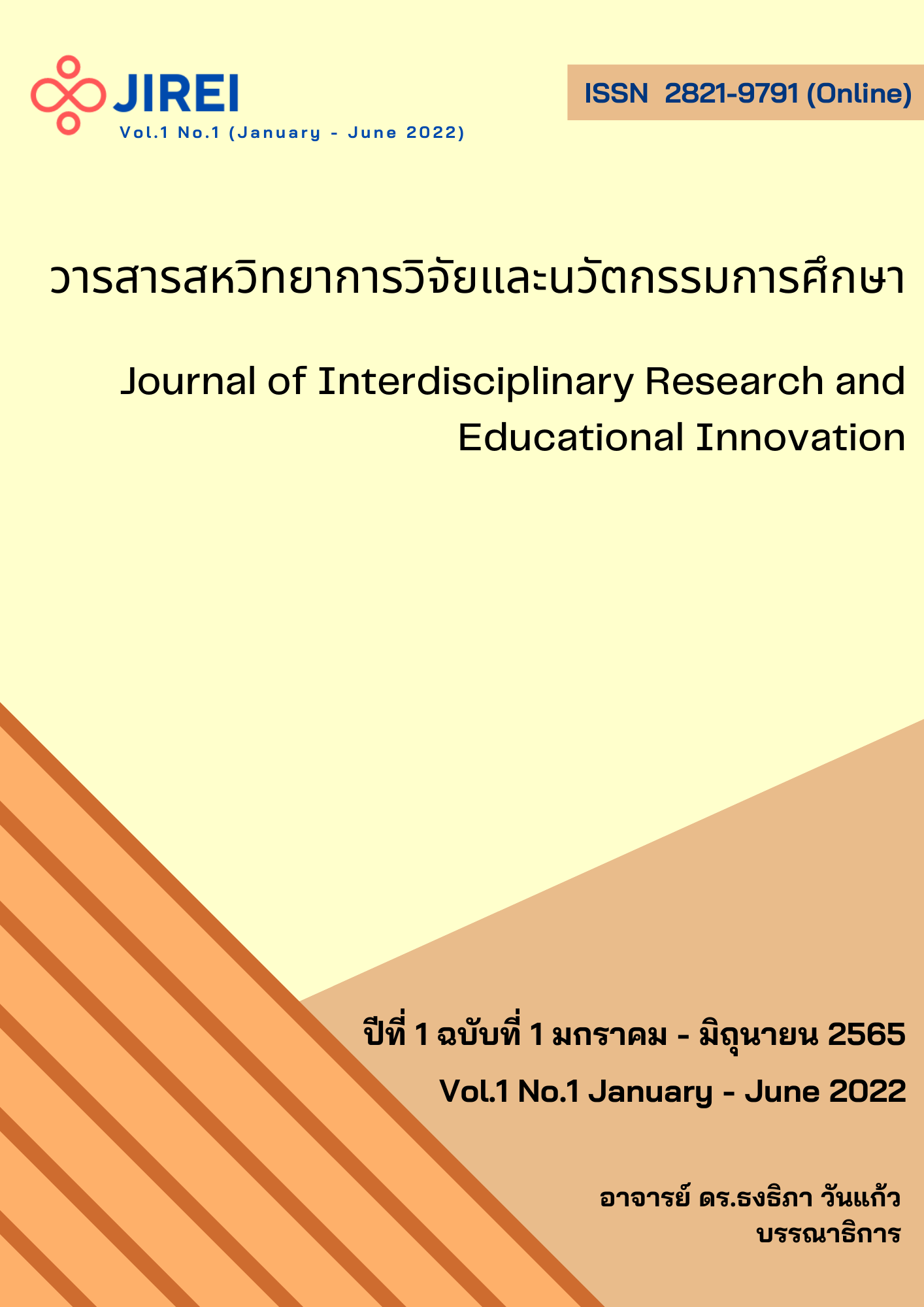Training Curriculum Development on Sexuality Education and Multicultural Society for Secondary School Students
Keywords:
การพัฒนาหลักสูตรการฝึกอบรม, เพศวิถีศึกษา, สังคมพหุวัฒนธรรม, Training Curriculum Development, Sexuality Education, Multicultural SocietyAbstract
The purposes of this research were to 1) study fundamental details of training curriculum development on sexuality education for elementary students, 2) develop the training curriculum on sexuality education for elementary students, 3) trial the training curriculum on sexuality education for elementary students, and 4) evaluate and improve the training curriculum on sexuality education for elementary students. The target group was 58 elementary students from the 2nd semester of academic year 2021 of Wattakramen School in Tha Maka district, Kanchanaburi province. They were selected by Purposive Sampling. Research tools consisted of 1) fundamental data exploration tools which were (1) questionnaire on instruction condition in the school and training requirement, (2) focus group discussion on needs and importance of the training curriculum development and 2) experimental tools which were (1) training curriculum on sexuality education and multicultural society for elementary students, (2) cognitive test, (3) attitude test, (4) self-practical evaluation test, and (5) questionnaire on the training curriculum. The statistics used in this research were percentage, mean, Standard Deviation, and t-test.
The results were as follows:
1. For fundamental details of the training curriculum development, it was found that the relating parties required the training curriculum development; 1) on learning: the students are able to practice and discover knowledge by themselves and work as a team and 2) on contents, hypothetical situation where knowledge can be applied in daily lives should be used with various and behavioral comprehensive measurements and evaluations.
2. For training curriculum development, it consists of 2 sections; 6 units of theoretical curriculum; Unit 1 LGBTQ+, Unit 2 My Body My Choice, Unit 3 Equality, No Violence, Unit 4 Fake Safety, Unit 5 It’s Me, and Unit 6 Living Together, Your House My Home, and sexuality education practices. The quality was in very good level.
3.For the application of the training curriculum, there were pre-training test by using the curriculum, It consists of principles, objectives, structure, learning activities, teaching material, measurement and evaluation. theoretical section and practical section in 2 days at Wattakramen School with lecturers, post-training test, and evaluation test.
4. For the evaluation of the training curriculum, it was found that (1) the student’s learning results after using the training curriculum were higher than the pre-training., (2) the students’ overall attitudes on sexuality education and multicultural society were in good level., (3) the students’ overall practical skills on sexuality education and multicultural society were in the highest level, and (4) the students’ overall opinions on the training curriculum on sexuality education and multicultural society were in the highest level.
References
จินดารัตน์ แก้วพิกุล. (2559). การวิจัยเชิงปฏิบัติการแบบมีส่วนร่วมในการพัฒนาหลักสูตรรายวิชาการศึกษาค้นคว้าและสร้างองค์ความรู้เพื่อพัฒนาทักษะการแสวงหาความรู้ด้วยตนเองของนักเรียนชั้นมัธยมศึกษาตอนต้นโรงเรียนมาตรฐานสากล [วิทยานิพนธ์ปรัชญาดุษฎีบัณฑิต ไม่ได้ตีพิมพ์]. มหาวิทยาลัยศรีนครินทร
วิโรฒ.
ฉรัต ไทยอุทิศ. (2547). การพัฒนาหลักสูตรฝึกอบรมการประเมินหลักสูตรสถานศึกษาสำหรับสถานศึกษาขั้นพื้นฐาน โดยหลักการ Balanced Scorecard [วิทยานิพนธ์การศึกษาดุษฎีบัณฑิต ไม่ได้ตีพิมพ์]. มหาวิทยาลัยศรีนครินทรวิโรฒ.
ชนสิทธิ์ สิทธิ์สูงเนิน. (2564). การพัฒนาหลักสูตร. ภาควิชาหลักสูตรและวิธีสอน คณะศึกษาศาสตร์ มหาวิทยาลัยศิลปากร.
ทวีป อภิสิทธิ์. (2551). เทคนิคการเป็นวิทยากรและนักฝึกอบรม (พิมพ์ครั้งที่ 3). โรงพิมพ์จุฬาลงกรณ์มหาวิทยาลัย.
ธงชัย ต้นทัพไทย. (2548). การศึกษาผลสัมฤทธิ์ทางการเรียนรูวิทยาศาสตร์และค่านิยมในการบริโภคอาหารของนักเรียนชั้นมัธยมศึกษาปีที่ 2 ที่สอนโดยใช้ชุดกิจกรรมพัฒนาศักยภาพการเรียนรู้ทางวิทยาศาสตร์ [วิทยานิพนธ์การศึกษามหาบัณฑิต ไม่ได้ตีพิมพ์]. มหาวิทยาลัยศรีนครินทรวิโรฒ ประสานมิตร.
ปาณิสรา ตะนุมงคล. (2564). การพัฒนาหลักสูตรฝึกอบรมเพื่อป้องกันการตั้งครรภ์ในวัยเรียนของนักเรียนโรงเรียนนางัวราษฎร์รังสรรค์ สังกัดสำนักงานเขตพื้นที่การศึกษามัธยมศึกษา เขต 22 [วิทยานิพนธ์คุรุศาสตร์มหาบัณฑิต ไม่ได้ตีพิมพ์]. มหาวิทยาลัยราชภัฏสกลนคร.
ปัญญ์กรินทร์ หอยรัตน์. (2560). วัยรุ่นไทยกับการมีเพศสัมพันธ์ก่อนวัยอันควร. วารสารวิทยาลัยพยาบาลพระปกเกล้า จันทบุรี, 28(2), 25.
นิรันดร์ จุลทรัพย์. (2554). การแนะแนวเบื้องต้น (พิมพ์ครั้งที่ 4). ศูนย์หนังสือมหาวิทยาลัยทักษิณ.
วิชัย วงษ์ใหญ่. (2554). การพัฒนาหลักสูตรระดับอุดมศึกษา. อาร์ แอนด์ ปริ้น.
วิชัย วงษ์ใหญ่ และมารุต พัฒผล. (2558). จากหลักสูตรแกนกลางสู่หลักสูตรสถานศึกษา : กระบวนทัศน์ใหม่การพัฒนา. จรัญสนิทวงศ์การพิมพ์.
ศูนย์เฉพาะกิจคุ้มครองและช่วยเหลือเด็กนักเรียน กระทรวงศึกษาธิการ. (2563). คู่มือการคุ้มครองและช่วยเหลือเด็กนักเรียน. ชุมนุมสหกรณ์การเกษตรแห่งประเทศไทย.
ศูนย์เฝ้าระวังทางวัฒนธรรม กระทรวงวัฒนธรรม. (2564, 2 พฤษภาคม). คู่มือการขับเคลื่อนงานการสร้างภูมิคุ้มกันของสังคมในมิติวัฒนธรรม. https://www.m-culture.go.th/surveillance/ewt_dl_link. php?nid=2140ใ
สิงหา จันทร์ขาว. (2558). การพัฒนาหลักสูตรสุขศึกษาและพลศึกษาสำหรับสามเณรระดับมัธยมศึกษาตอนต้นในโรงเรียนพระปริยัติธรรม. วารสารครุศาสตร์, 10(1), 157-168.
สุชาติ โสมประยูร และเอมอัชฌา วัฒนบุรานนท์. (2553). เทคนิคการสอนสุขศึกษาแบบมืออาชีพ. ดอกหญ้า วิชาการ.
สุเทพ อ่วมเจริญ. (2557). SU Model: การประยุกต์การจัดการเรียนรู้แบบสร้างองค์ความรู้. วารสารวิชาการ Veridien E-Journal, 7(3), 945-961.
สำนักคณะกรรมการการศึกษาแห่งชาติ. (2543). ปฏิรูปการเรียนรู้ผู้เรียนสําคัญที่สุด. บริษัทพิมพ์ดี.
สำนักงานคณะกรรมการการศึกษาขั้นพื้นฐาน. (2549). แนวทางการประเมินตามสภาพจริง. ชุมนุมสหกรณ์การเกษตรแห่งประเทศไทย.
องค์การการศึกษาวิทยาศาสตร์และวัฒนธรรมแห่งสหประชาชาติ. (2562, 29 มิถุนายน). แนวปฏิบัติสากลทางวิชาการ เรื่องเพศวิถีศึกษา โดยใช้แนวทางที่มีหลักฐานทางวิทยาศาสตร์สนับสนุน (ฉบับปรับปรุง). https://unesdoc.unesco.org/ark:/48223/pf0000368655
Banks, A. J. (2001). Cultural diversity and Education : Foundation. Curriculum and Teaching. Pearson/Allyn and Bacon.
Best, J. W. (1981). Research in Education. Prentice–Hall.
Cortes, C. E. (1996). The Children Are Watching: How the Media Teach About Diversity. Teacher College Press.
Oliva, Peter F. (1992). Developing The Curriculum. (3 rd ed). Harper Collins Publishers.
Taba, H. (1962). Curriculum Development. Theory and Practice. Harcourt Brace & Word.
Tyler, R. W. (1969). Basic Principles of Curriculum and Instruction. The University of Chicago Press
Vygotsky, L. S. (1978). Mind in society : The developmental of higher psychological processes. (V. J. S. In M. Cole, S. Scribner & E. Suberman Ed.). Harvard University Press.
World Health Organization. (1998). Education for health: a manual on health education in primary health care. World Health Organization.




